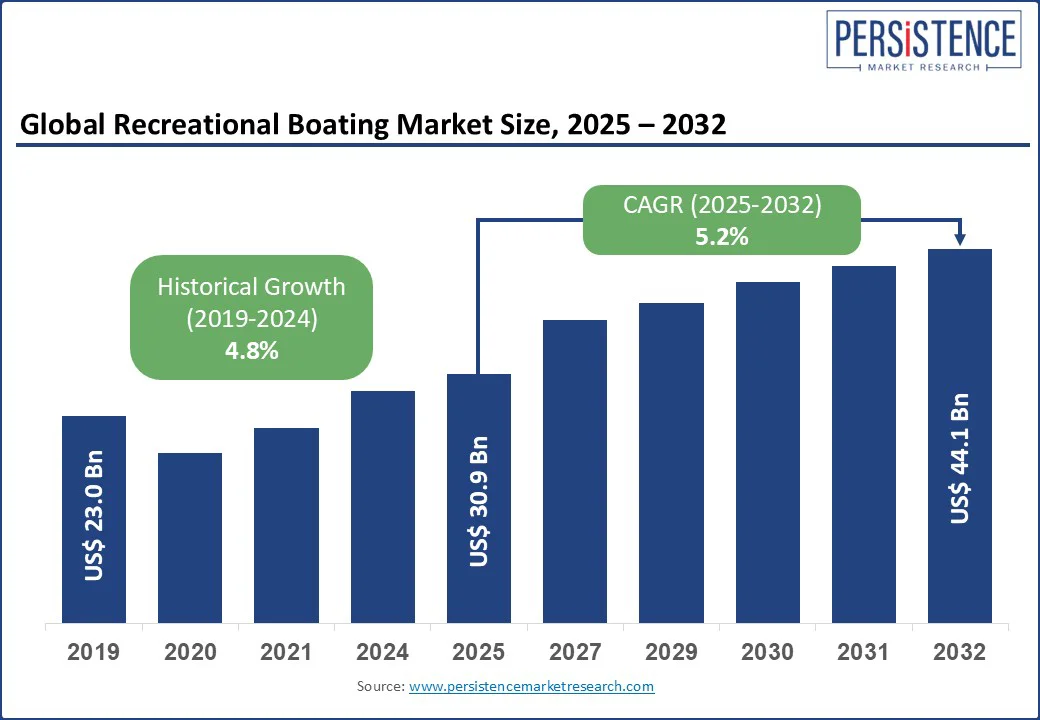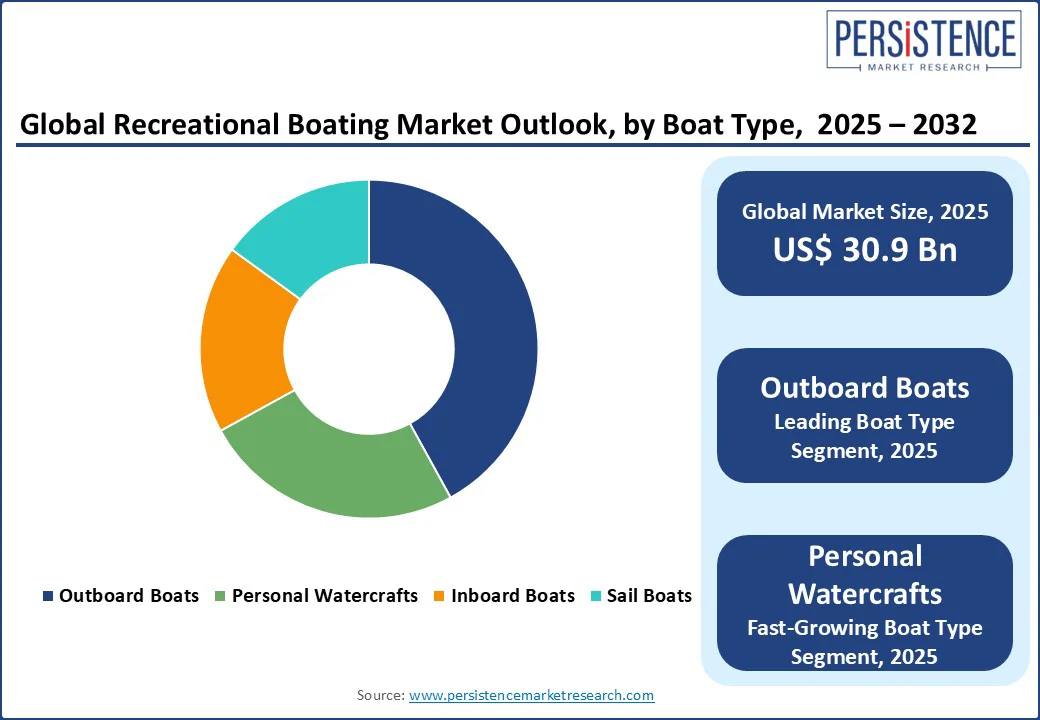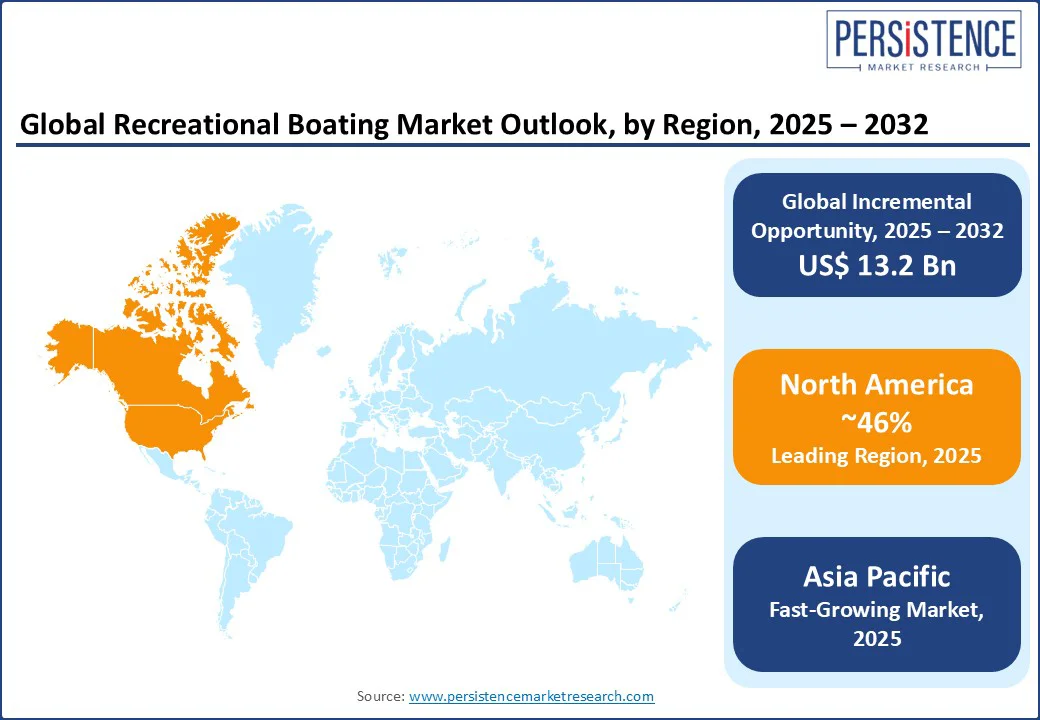ID: PMRREP3530| 202 Pages | 13 Aug 2025 | Format: PDF, Excel, PPT* | Consumer Goods

The global Recreational Boating Market size is projected to rise from US$ 30.9 Bn in 2025 to US$ 44.1 Bn by 2032, registering a CAGR of 5.2% during the forecast period from 2025 to 2032.
The recreational boating industry has experienced steady growth, driven by increasing consumer interest in outdoor leisure activities, rising disposable incomes, and advancements in boat manufacturing technologies.
The sector is propelled by the demand for versatile, high-performance boats that cater to a wide range of activities, from watersports to luxury cruising. The sector is also supported by the growing popularity of boating tourism and charter services, particularly in coastal and island regions.

Key Industry Highlights:
|
Key Insights |
Details |
|
Recreational Boating Market Size (2025E) |
US$ 30.9 Bn |
|
Market Value Forecast (2032F) |
US$ 44.1 Bn |
|
Projected Growth (CAGR 2025 to 2032) |
5.2% |
|
Historical Market Growth (CAGR 2019 to 2024) |
4.8% |
The recreational boating market is experiencing significant growth due to rising disposable incomes and a growing consumer preference for outdoor leisure activities. As global economies recover and middle-class populations expand, particularly in emerging markets, individuals are increasingly investing in recreational boating as a lifestyle choice.
The steady rise in income levels has supported growing demand for leisure products, including recreational boats.
In developed regions such as North America and Europe, boating has long been a popular recreational activity. The appeal of boating as a family-friendly, socially engaging outdoor pursuit continues to attract a wide consumer base, driving demand for a variety of boats, from affordable outboard models to luxury yachts. Additionally, government initiatives promoting tourism and coastal recreation have further amplified consumer interest, positioning boating as a key driver of market expansion.
For instance, the U.S. Discover Boating campaign has successfully raised awareness and participation in boating, especially among younger and first-time boaters, strengthening domestic demand.
The high costs associated with boat ownership and maintenance represent a significant barrier to market growth, particularly for middle- and lower-income consumers. Purchasing a recreational boat, even at the entry level, requires a substantial upfront investment. Additionally, ongoing expenses such as docking fees, fuel, insurance, and regular maintenance contribute to the overall financial burden of ownership. These recurring costs can deter potential buyers, especially in price-sensitive markets.
The challenge is further amplified in developing regions, where limited marina infrastructure and high import duties on boats can significantly raise ownership expenses. Moreover, operating and maintaining recreational boats often requires specialized skills, which may not be readily available in regions with less established boating cultures.
For instance, in parts of Southeast Asia and Africa, underdeveloped boating infrastructure and lack of formal training programs have restricted recreational boating to affluent consumers or commercial operators. While advancements in cost-effective manufacturing are helping to reduce some production costs, the overall financial commitment associated with boat ownership remains a major restraint on the broader adoption of recreational boating.
The development and adoption of sustainable and electric boating technologies present a significant opportunity for market growth. As environmental concerns rise, consumers and manufacturers are increasingly prioritizing eco-friendly solutions, such as electric and hybrid boats, which reduce carbon emissions and fuel consumption. This shift is being driven by innovations in battery technology and supportive regulations in regions such as Europe and North America.
Companies such as Brunswick Corporation and Yamaha Motor are investing heavily in electric propulsion systems, with models such as Brunswick’s Veer electric outboard boats gaining traction in the leisure market. For instance, in recent years, Groupe Beneteau introduced a range of electric and hybrid-powered leisure boats as part of its environmental strategy, showcasing the industry's growing commitment to clean technologies.
Additionally, government incentives, such as the EU’s Green Deal, which promotes sustainable marine transport, are encouraging manufacturers to develop greener vessels. The expansion of sustainable boating technologies not only appeals to environmentally conscious consumers but also opens new markets in regions with stringent environmental regulations, positioning electric and hybrid boats as key drivers of long-term industry growth.
Outboard boats dominate the recreational boating market, expected to account for approximately 42.0% of the industry share in 2025. Their leadership stems from their versatility, affordability, and ease of use across a wide range of applications, including fishing, watersports, and leisure cruising. Outboard boats are favored for their compact design, fuel efficiency, and compatibility with various water conditions, making them a popular choice for both novice and experienced boaters. Manufacturers such as Yamaha Motor and Brunswick Corporation have driven demand through continuous innovation, offering models with enhanced performance and smart technology integration.
Personal watercrafts (PWCs) are the fastest-growing segment from 2025 to 2032, driven by their appeal to younger demographics and the rise of watersports activities. PWCs, such as jet skis, offer high-speed, agile performance, making them ideal for thrill-seekers. In addition to their recreational appeal, the segment is benefiting from innovations in lightweight materials, improved fuel efficiency, and electric models that cater to eco-conscious users.
Fiberglass dominates the recreational boating market, accounting for approximately 64.0% of the industry share in 2025. Its widespread use is attributed to its durability, lightweight properties, and cost-effectiveness compared to alternatives such as wood or steel.
Fiberglass boats are highly customizable, allowing manufacturers to produce a wide range of designs for various applications, from small fishing boats to luxury yachts. Leading companies such as Groupe Beneteau and Azimut-Benetti Group rely heavily on fiberglass for their production lines, ensuring consistent demand.
Aluminum is the fastest-growing material type, driven by its strength, recyclability, and suitability for smaller, lightweight boats. Aluminum boats are particularly popular in North America and Australia for fishing and recreational use in inland waters. Their resistance to corrosion and lower maintenance costs compared to fiberglass make them an attractive option for cost-conscious consumers. Innovations in aluminum manufacturing, such as advanced welding techniques, are further boosting adoption, especially in emerging markets.
Watersports account for 39.2% of the recreational boating market revenue, driven by water skiing, wakeboarding, tubing, kite surfing, and jet skiing. The rising popularity of active, outdoor lifestyles, especially among younger demographics, has significantly boosted demand for boats tailored to watersports.
In developed markets such as North America and Europe, watersports are a key recreational activity supported by extensive coastal and inland water infrastructure, along with strong participation in marine tourism.
The tourism & charter segment is the fastest-growing, fueled by the global expansion of marine tourism and charter services. Coastal and island destinations, such as the Caribbean, Mediterranean, and Southeast Asia, are seeing increased demand for chartered yachts and recreational boats for group tours and private rentals.
According to the World Tourism Organization, marine tourism grew by 7% annually from 2019 to 2024, driving demand for boats designed for commercial and tourism applications. Companies such as Princess Yachts and Sunseeker International are capitalizing on this trend by offering luxury charter vessels.

In North America, holding a 46% market share in 2025, the United States remains the leading force in the recreational boating market. This dominance is supported by a strong boating culture, extensive coastline, and the presence of key industry players such as Brunswick Corporation, Malibu Boats, and MasterCraft Boat Holdings.
The U.S. market is driven by high consumer demand for leisure and watersports activities, with the NMMA reporting that recreational boating contributed $170 billion to the U.S. economy in 2024. The popularity of outboard boats and PWCs, coupled with innovations in smart boating technologies, such as GPS-enabled navigation systems, is accelerating market growth.
Clinical applications, such as fishing and watersports, are expanding rapidly, with companies such as Yamaha Motor introducing high-performance outboard engines tailored for these activities.
However, challenges such as high ownership costs and environmental regulations, including restrictions on fuel emissions, pose barriers for smaller manufacturers and new entrants. Despite these challenges, the U.S. market is expected to maintain steady growth, supported by consumer demand and infrastructure investments in marinas and boating facilities.
Europe holds a significant position in the global recreational boating market, supported by robust tourism industries, advanced manufacturing capabilities, and increasing adoption of sustainable boating technologies. Key contributors to regional growth include Italy, the UK, and France. Italy leads with its strong yacht manufacturing sector, with companies such as Azimut-Benetti Group and Ferretti Group driving innovation in luxury and sustainable vessels. The UK benefits from a rich maritime heritage and initiatives such as the UK Marine Industries Alliance, which promotes boating tourism and infrastructure development.
France is advancing through its focus on eco-friendly boating, with investments in electric and hybrid vessels supported by the EU’s Green Deal. At the European level, programs such as Horizon Europe are fostering innovation in marine technologies, including lightweight materials and energy-efficient propulsion systems. However, the region faces challenges in complying with stringent environmental regulations, such as the EU’s Emissions Trading System, which can increase production costs. Nonetheless, Europe’s recreational boating market is poised for steady growth, driven by tourism demand and technological advancements.
Asia Pacific is the fastest-growing region in the global recreational boating market, expected to hold a significant market share by 2025. The growth is primarily led by China and Australia, both of which are investing heavily in marine tourism and recreational infrastructure.
China benefits from government-backed initiatives, such as the Belt and Road Initiative’s maritime components, which promote coastal tourism and boating infrastructure. Companies such as Sunseeker International are expanding their presence in China, offering luxury yachts tailored to affluent consumers.
In Australia, the recreational boating market thrives on a strong coastal culture and increasing demand for watersports and fishing boats. The BIA reports nearly 905,000 registered vessels and identifies personal watercraft as the fastest-growing segment, reflecting expanding consumer interest. The region’s large population, rising disposable incomes, and lower production costs for aluminum and fiberglass boats contribute to market acceleration. However, underdeveloped marina infrastructure in rural areas remains a barrier to widespread adoption across the region.

The global recreational boating market is highly competitive, featuring a blend of international marine giants and niche manufacturers. In developed regions such as North America and Europe, companies such as Brunswick Corporation, Yamaha Motor, and Groupe Beneteau dominate through advanced engineering capabilities, broad product portfolios, and strategic collaborations with marine electronics and propulsion technology providers.
In the Asia Pacific, rising coastal tourism and expanding middle-class populations are attracting both local boatbuilders and global players. Companies are increasingly focusing on sustainability, digital integration, and customization to differentiate their offerings. Strategic partnerships, innovation in electric propulsion, and premium design are further intensifying the competitive landscape.
The Recreational Boating market is projected to reach US$ 30.9 Bn in 2025.
Rising disposable incomes and interest in outdoor leisure activities are key drivers.
The Recreational Boating market is poised to witness a CAGR of 5.2% from 2025 to 2032.
Growth in sustainable and electric boating technologies is a key opportunity.
Brunswick Corporation, Yamaha Motor Co., Ltd., and Azimut-Benetti Group are key players.
|
Report Attribute |
Details |
|
Historical Data/Actuals |
2019 - 2024 |
|
Forecast Period |
2025 - 2032 |
|
Market Analysis Units |
Value: US$ Bn/Mn, Volume: As Applicable |
|
Geographical Coverage |
|
|
Segmental Coverage |
|
|
Competitive Analysis |
|
|
Report Highlights |
|
|
Customization and Pricing |
Available upon request |
By Boat Type
By Material Type
By Application
By Region
Delivery Timelines
For more information on this report and its delivery timelines please get in touch with our sales team.
About Author